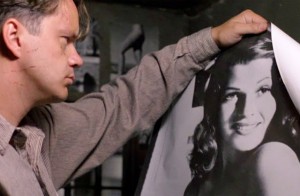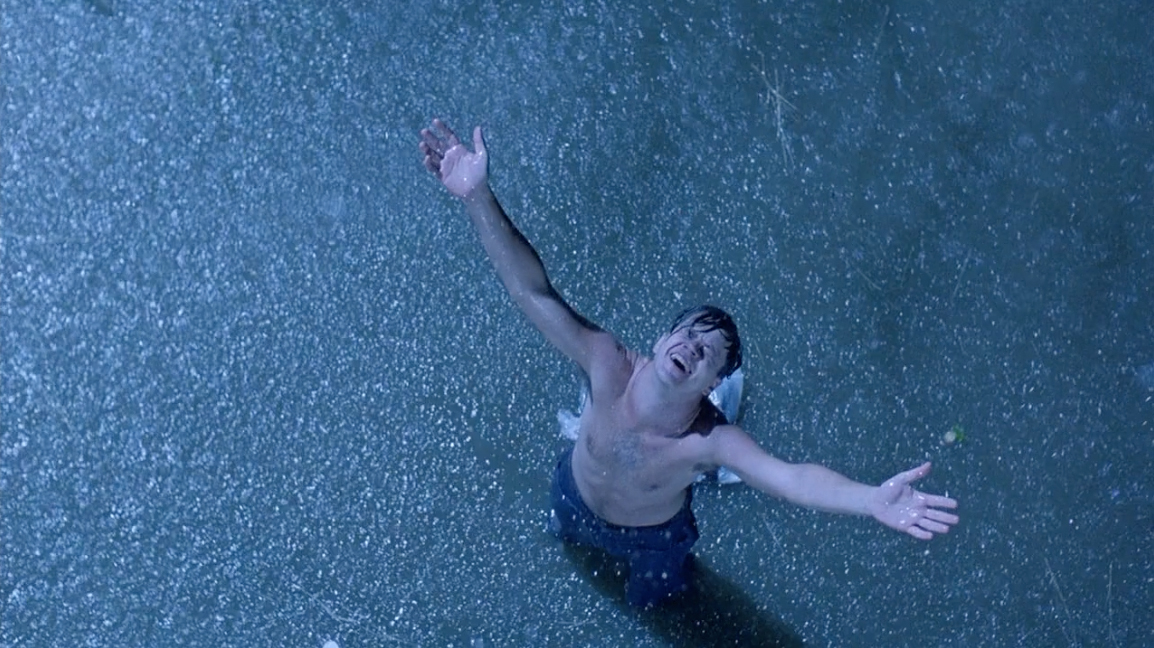 |
| No frienship is complete without a a voice over narration |
Prison ‘lifer’ Andy Dufresne tells fellow inmate,
Red, get busy living or get busy dying. This line encompasses the entire
message and appeal of the 1994 film The
Shawshank Redemption. Based off of the Stephen King novella “Rita Hayworth
and the Shawshank Redemption”, the film relates the struggle of a falsely
convicted man to maintain hope and dignity while enduring the trials and humiliations
of life in prison. Though it made little commercial impact during its
theatrical release, the film, like its hero, triumphed above the obstacles in its
way and went on to gain a devoted following and critical acclaim. The film is a truly resonant story which uses
the harsh realities of prison as the backdrop for a tale of
injustice, corruption, friendship, and ultimately, hope.
The story begins in 1947, as bank vice president
Andy Dufresne (Tim Robbins) loads a gun and drinks a bottle of whiskey in his
car after discovering his wife’s affair with another man. The scene then
flashes ahead as Andy is facing trial for the murder of his wife and her lover.
Although Andy relates a consistent story and repeatedly proclaims his
innocence, his seeming detachment leads the jury to convict him of first degree
murder. He is then sentenced to a life sentence in the notoriously brutal Shawshank Prison.
His mild manner leads fellow lifer, Red (Morgan Freeman), to place a bet that
Andy will be the first of the new recruits to break down upon entering prison.
To the prisoners’ surprise, Andy “never made a sound”, earning him Red’s
begrudging respect ,which later forms the basis of an enduring friendship
between them. Unfortunately, it is this same dignity that makes Andy a target
for a particularly brutal gang of prisoners known as “The Sisters”, who do all
that is in their power to assert their dominance and break his spirit.
Despite the seemingly endless degradations that he
is forced to endure, Andy eventually discovers an opportunity when he overhears
a guard (Clancy Brown) complaining about paying taxes on his recent
inheritance. Using his banking expertise, he helps the guard use various legal
loopholes to avoid paying the unwanted tax fees. The guard is so delighted that
he brings Andy’s work to the attention of the other guards, and eventually to the attention of the
prison’s hypocritical warden (Bob Gunton). Rather than using his new position
as the guards’ favorite strictly to his own advantage, Andy uses his influence
to obtain favors that benefit his fellow prisoners as well, including the instituting
of a prison library and education program. Through his efforts, he reminds his
fellow inmates of their humanity and provides them with the motivation to keep going.
Eventually, Andy learns that the warden ordered the execution of a fellow
inmate (Gil Bellows) in order to prevent the truth of Andy’s unjust conviction
from coming to light. Upon learning of
this revelation, he concocts a plan that will make him a legend amongst his fellow prisoners.
 |
| An all-purpose pin-up girl |
One of the most striking aspects of the film is the
way in which it portrays the reality of prison life while still maintaining an
uplifting tone. One of the keys to the film’s balance between authenticity and
outright resignation is its emphasis upon justice. Although the events of the
story are set in motion by the miscarriage of justice at Andy’s trial, a
greater, divine, justice later comes into play and works the prison system's corruption
against itself. For instance, when Bogs (Mark Rolston) is finally forced to
answer for the atrocities he has committed against Andy and countless other
prisoners, it is not at the hands of the abused inmates, but those of the
equally abusive guard, Hadley. Similarly, when Andy learns information needed to
exonerate himself, he does so through an inmate he has been tutoring, rather
than through his own research. In both of these instances, Andy is provided
with assistance in unlikely places, which hint at the possibility that his
prayers may be heard after all. When Andy is finally able to attain his revenge
against the warden and prison staff in the film’s climax, he assumes a
Christ-like pose, revealing that a greater justice has indeed been served.
The film’s greatest strength and most uplifting
aspect is the bond between Andy and Red. Upon their first meeting, the men
appear to be complete opposites. Despite their racial, socio-economical, and experiential
differences, however, they are able to see through to their basic similarity;
their mutual need for freedom. The film makes this friendship believable by
having Andy gradually earn Red’s trust and respect over time, rather than
having the men form an instant friendship. Over the course of the next twenty
years, they provide each other with the humor, emotional support, and basic
human interaction that they need to cope with life behind bars. It is this
mutual support that enables them to hang onto what little hope they have left
and keep working towards a bearable, if not better, tomorrow. Ultimately, it is not
Andy’s attainment of justice or revenge, but the final reunion between these
two friends that proves to be the film’s most effective moment.
The
Shawshank Redemption is a true classic that speaks to the humanity
in us all. The film relates the importance of friendship and hope in all our
lives through one man's struggle and eventual salvation. The story is heartfelt without being
sentimental, and authentically gritty without being despairing. Few films have been
able to explore the highs and lows of human nature so convincingly. So, get
busy living and try a stint in Shawshank; it will be one sentence you won’t
want to end.
 |
| Freedom's rain beats prison plumbing every time |

Hope is indeed a beautiful thing. One of my favourite movies and the book is brilliantly written too; Stephen King is wonderful. Andy Dufresne is one of my favourite male film characters: http://www.thezarinamachablog.co.uk/2017/04/15-favourite-males-in-film-and-tv.html
ReplyDeletehe's such an inspiration in the fact that he never gives up against the odds. Red is also great and their friendship is beautifully played out. Lovely analysis.